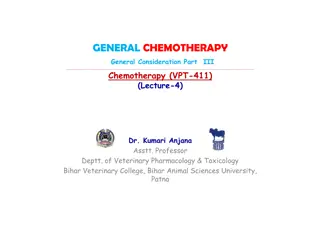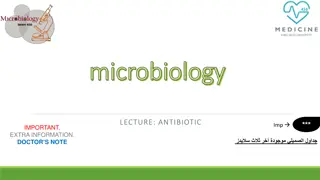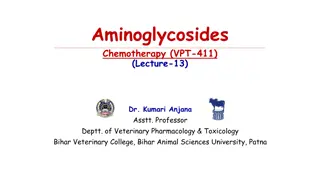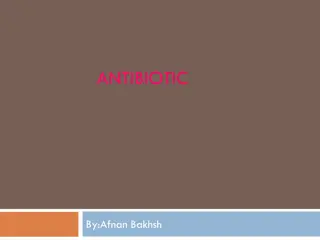Ideal Antimicrobial Agents and Antimicrobial Classification Overview
This lecture on general chemotherapy outlines the properties of ideal antimicrobial agents, emphasizing selective and effective activity, bactericidal action, non-toxicity, and more. It also covers the classification of antimicrobials based on chemical structure, including sulfonamides, diaminopyrim
6 views • 19 slides
Understanding Antibiotics: Mechanisms of Action and Therapeutic Index
Antibiotics play a crucial role in combating microbial infections by either killing or inhibiting bacteria. This lecture covers important topics such as the difference between bactericidal and bacteriostatic antibiotics, spectrum of activity, and the therapeutic index. It also explores the mechanism
0 views • 23 slides
Understanding Aminoglycosides in Veterinary Pharmacology
Aminoglycosides are a crucial group of antibiotics in veterinary medicine, known for their bactericidal properties and shared chemical characteristics. This class of drugs has a rich history, with members like streptomycin, neomycin, kanamycin, gentamicin, and amikacin. Chemistry-wise, aminoglycosid
0 views • 40 slides
Advances in Antimicrobial Drugs: Selective Toxicity and Classification
The development of antimicrobial drugs has significantly improved therapeutics by controlling infections and preventing complications. These drugs target invading microorganisms using selective toxicity, sparing host cells. Antimicrobial drugs are classified based on site, mechanism of action, and c
0 views • 30 slides
Understanding Antibiotics: Types, Mechanisms, and Testing
Antibiotics are compounds produced by living organisms that inhibit or kill other organisms, categorized as bactericidal or bacteriostatic. This article explores the types of antibiotics, mechanisms of action against bacteria, and the importance of sensitivity testing to determine drug effectiveness
0 views • 22 slides




